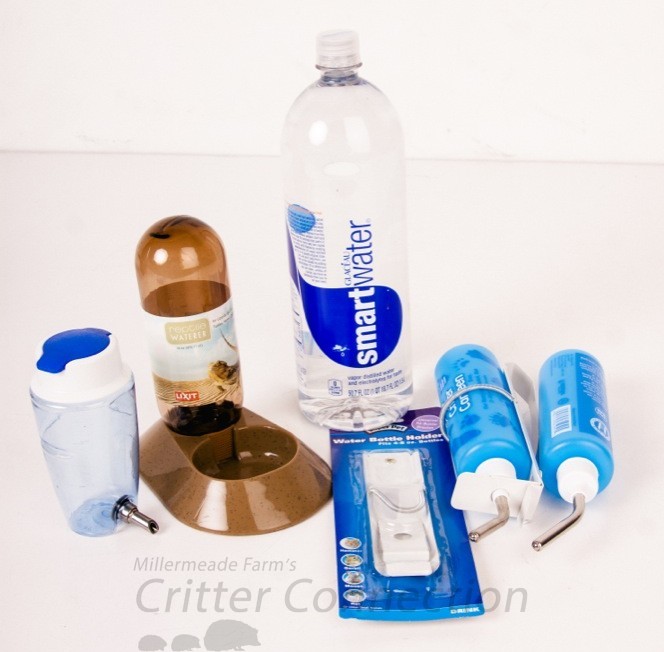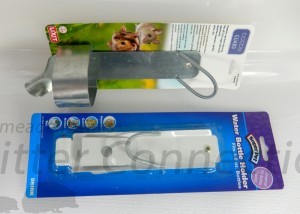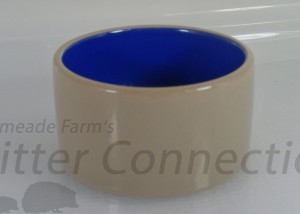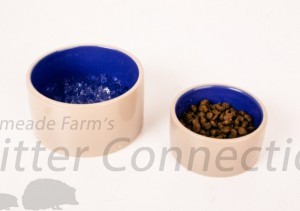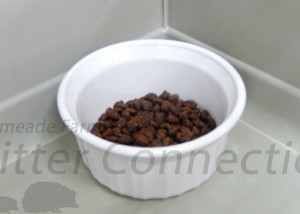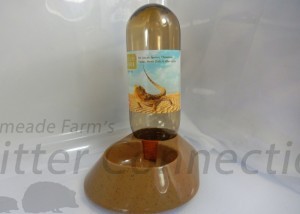Last Updated on November 18, 2021.
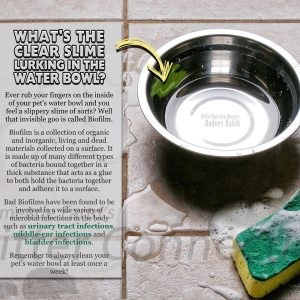
Water Bottles
- Water bottles are one of the most popular methods of offering fresh, clean water to small mammals including hedgehogs.
- The tip of the water bottle should hang at your hedgehog’s shoulder height.
- We encourage you to always monitor your hedgehogs to make sure they are drinking freely from their bottle.
- Online pet accessory stores carry inexpensive bottle-brushes that will help keep the bottle clean. Baby bottle-brushes will also fit in many traditional water bottles.
- Both glass and plastic bottles are available. Glass bottles are typically used for chinchillas and lab animals and are much more difficult to find than plastic bottles.
- Fresh water receptacles and water should be given every 24 hours. Some hedgehogs are so messy with their feet in their water, their water bowl is changed 2x a day.
- Special brushes designed for water bottles clean more thoroughly that simple rinsing.
Advantages of Bottles
- Water bottles are typically less messy compared to dishes especially if bedding is being used other than cage liners.
- Water bottles are easy to clean.
- They typically mount on the side of the cage so that there is more floor space available for the hedgehog.
- Water bottles come in a variety of shapes and styles and are relatively inexpensive.
- It is easier to monitor how much water your hedgehog is actually drinking with a water bottle as opposed to water being spilt out of a water bowl.
VIDEO.: Water bottles for your hedgehog
VIDEO.: We prefer to use water bottles over bowls in our breeding room
Disadvantages of Bottles
- The water bottle should be checked every day to ensure the bottle is working properly and not plugged with bits of bedding or other debris.
- You may consider switching to a water bowl if you notice your hedgehog chewing or jerking on the metal tip of the water bottle. A hedgehog can damage its teeth on the tip of the bottle.
- It is a good idea to replace plastic bottles after one year. Toxins can leach out of the bottles as they age.
- Replacing water bottles on a regular basis is a simple and relatively inexpensive safety precaution.
- There are reports of hedgehogs getting their tongues stuck in the tips of water bottles with damage to the point of tongue amputations. However, in 13 years of breeding hedgehogs we have never had experience with such misfortune.
Leaky Bottles
- Most bottles will leak until a vacuum is established within the bottle. (Ginger)
- According to information provided by Ginger Manufacturing: For best results, fill your water bottle with water that is slightly warmer than room temperature. Invert the bottle and touch the ball tip a few times to release enough water to establish a vacuum.
- If you fill your water bottle with cold water, it will continue to drip until the water reaches room temperature and establishes a vacuum. Occasional drips will occur while the water inside adjusts to higher room temperature changes. (Ginger).
- Do NOT place your animal or water bottle in direct sunlight.
- Your water bottle is likely to drain if the tip is allowed to maintain contact with the bedding material, the side of the cage, or anything else within the cage.
Water Bottle Hangers
- Our water bottles fit inside hangers that are attached inside the cage.
- The hanger is sturdy, hence the water bottle is not easily pushed out of the hanger and the hanger is not easily knocked off the cage if attached properly.
- Our experience with the “U” shaped wire clips (that are often included in the package with the bottle) is that they are not well suited for hedgehogs or their cages.
- This type of hanger either doesn’t allow the bottle to hang low enough in the cage or it is knocked off easily.
Water Bowls
- Baby hedgehogs or hedgehogs that have difficulty using a bottle may do better with a water bowl.
- Some hedgehog owners prefer using glass or stainless steel bowls for drinking.
- Hedgehogs may be able to get more water faster by lapping from a bowl than from a water bottle.
- Water bowls will need to be checked frequently to make sure they are clean and full.
- Wood or paper bedding can make quite a mess in water bowls.
- Hedgehogs lap water from the edge of a pool of water in the wild. A hedgehog needs to put its long snout down into a bowl to drink. This can present a problem for your hedgehog because it can aspirate on the water (inhale water through its nose into its lungs). (Martin).
Bowl Tips
- Food dishes should be heavy enough that they are not easily tipped and large enough to keep bedding from contaminating the food.
- We recommend the four-inch crock style food dish.
- One suggestion to prevent bedding from getting into the bowl is to put the bowl atop a large garden sidewalk paver or other flat stone (properly disinfected of course).
- The stone will also naturally help to wear down the hedgehog’s nails and give additional exercise and stimulation.
Types of Bowls
Crocks
- Crocks are the most common food and water dish in the pet industry.
- The heavy ceramic crocks are preferred to the lightweight plastic crocks because they are not as easily tipped and used as a toy.
- We sometimes use the 2 1/2” to 3” size crocks for babies and for treats. The larger 4” crocks seem to work better for adult hedgehogs.
- The 4” crocks help prevent bedding from contaminating the food.
- Crocks can be easily sterilized in the dishwasher or sink.
- In the past, many crocks had a blue glaze inside that contained a lead base glaze. The current production standards for many companies no longer allow lead in glazes used for pet products. However, if you are in doubt about the safety of your crocks, many other options are available.
- Always replace the crocks if the interior glaze is chipped or any part of the crock itself is chipped to avoid cuts and collection of germs inside the crack.
- The Bartel family are customers who gave us a great tip for keeping hedgehogs from tipping their crocks. They glue the crock to a piece of ceramic flooring tile. The tiles are inexpensive, easy to clean, and can be discarded with the crock if one should break. Choose a tile that has smooth edges rather than one that has sharp sides that could injure your pet.
Human Dishes
- The advantage of using human grade dishes is that they are guaranteed to be safe for pets.
- Some pet owners use small 3” ramekin dishes for their pets.
- The restaurant style hard plastic ramekins (small dishes used for baking and serving an individual portion of food).
- Ramekins are easy to clean and typically will not break.
- Dessert bowls or small cooking dishes are similar in size to 4” crocks, but they may not be as heavy as crocks and can be easily tipped.
Reptile Dishes
- This style of dish is sold for reptiles but it has low sides, which is especially nice for young hedgehogs.
- The corner dish fits nice and tight into an aquarium, which saves limited floor space.
- The dishes are relatively heavy and not easily tipped.
- Some hedgehogs may choose to use this dish as a litter pan because it is easy for them to climb in and out of the dish.
- They have a rough texture and may be a little more difficult to clean than dishes with smooth surfaces.
- This style of dish is also quite costly.
Coop-Cups
- This style of dish is sold for birds, rabbits, or other animals that are able to eat up off the ground.
- Brackets attach the cup or dish to the sides of the wire cage.
- This type of dish will require giving your hedgehog a boost up to the appropriate should height needed for drinking.
- The garden stone mentioned above will work quite nicely.
- One concern with using this type of dish is that boosting your hedgehog up to the wire level of the cage may encourage climbing which is not always a good idea.
- Refer to our Behavioral Characteristics guide for more information about hedgehog’s agility and climbing abilities.
Switching from Bottle to Bowl or Bowl to Bottle
- If you decide to switch your hedgehog’s water receptacle, try offering both types (bottle and bowl) for several days. You should never just switch them to a new and foreign way of drinking without being 100% sure that they have learned to drink from the new source.
- Hang the bottle over the water dish to entice drinking of both receptacles.
- Be patient and give plenty of time for your hedgehog to get the hang of the bottle or bowl.
- Keep in mind that once a hedgehog is used to one or the other, it may be difficult for it to make the switch.
Regardless of the type of dish you use, you will want to wash and disinfect it on a regular basis.
Contributors: Amber Marcantel Petry, Louisiana Hedgehog Rescue, Rodney Habib, Shelly Fowler, Beach Bum Hedgehogs; Nicole Gendler-Martin, formerly of Hedgehogs in Space; Laura Bartel, formerly of Laura’s Little Hedgehogs



